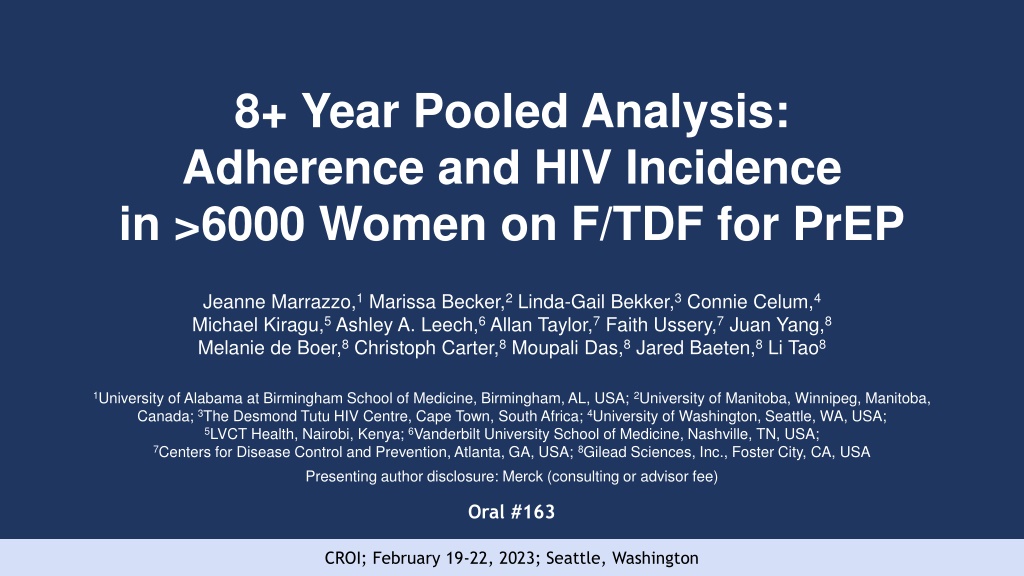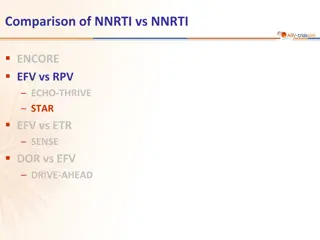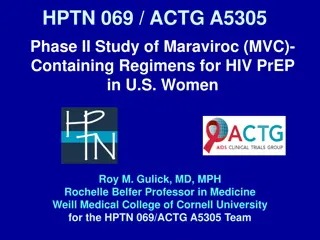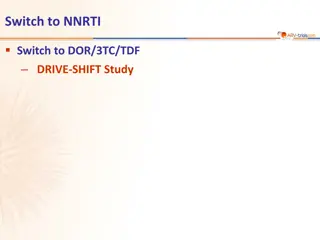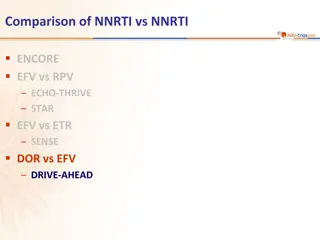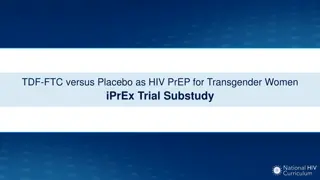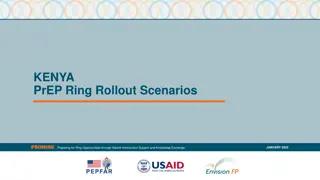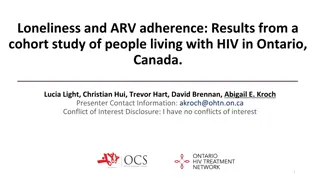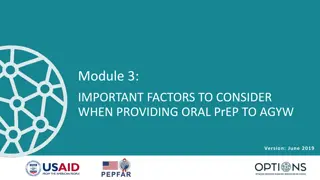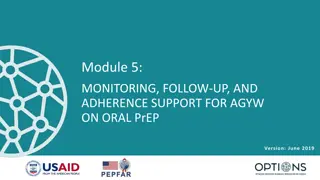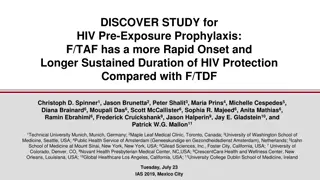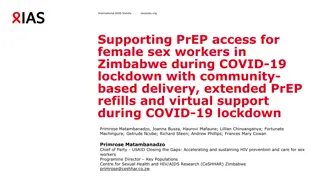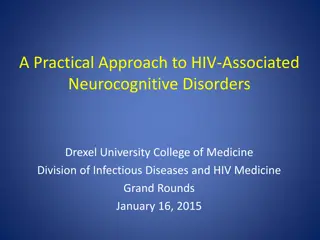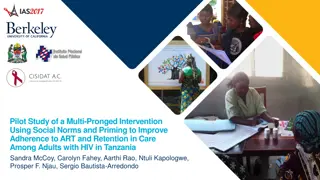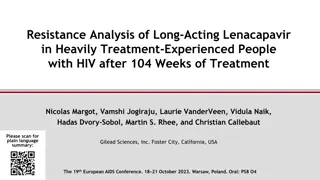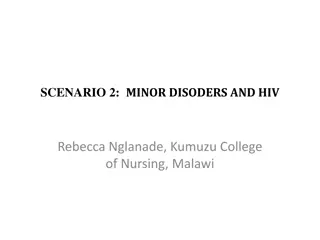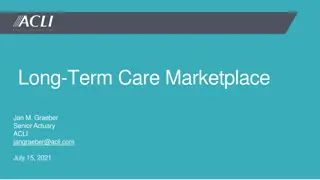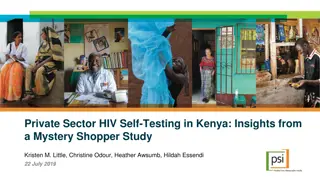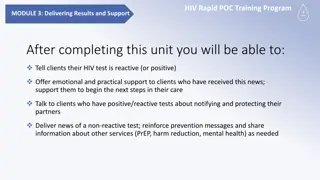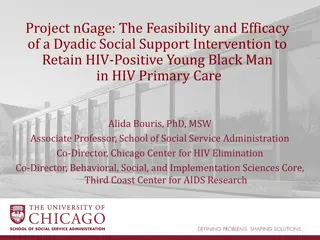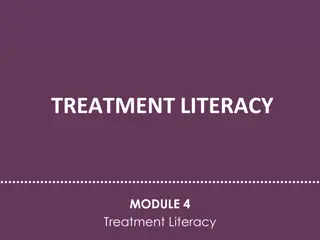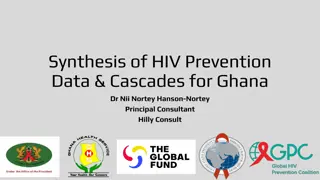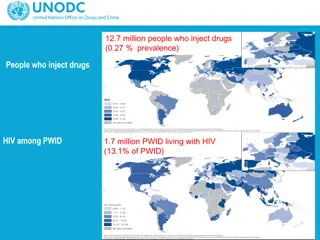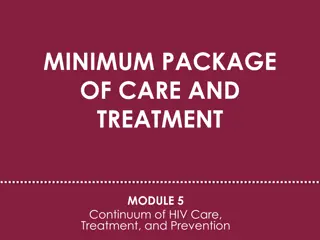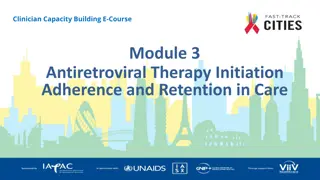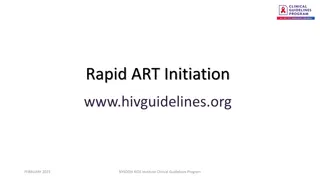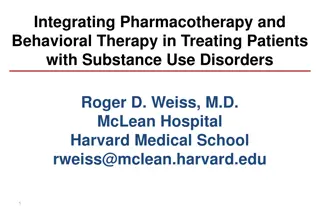Long-term Adherence and HIV Incidence in Women on F/TDF for PrEP
Pooled data from 11 F/TDF demonstration projects involving over 6000 cisgender women over eight years examined adherence and HIV incidence. The study aimed to assess the effectiveness of F/TDF for HIV prevention in real-world settings, revealing adherence patterns in a subset of participants. This research provides valuable insights into the use of PrEP in women to reduce HIV risk.
Download Presentation

Please find below an Image/Link to download the presentation.
The content on the website is provided AS IS for your information and personal use only. It may not be sold, licensed, or shared on other websites without obtaining consent from the author. Download presentation by click this link. If you encounter any issues during the download, it is possible that the publisher has removed the file from their server.
E N D
Presentation Transcript
8+ Year Pooled Analysis: Adherence and HIV Incidence in >6000 Women on F/TDF for PrEP Jeanne Marrazzo,1 Marissa Becker,2 Linda-Gail Bekker,3 Connie Celum,4 Michael Kiragu,5 Ashley A. Leech,6 Allan Taylor,7 Faith Ussery,7 Juan Yang,8 Melanie de Boer,8 Christoph Carter,8 Moupali Das,8 Jared Baeten,8 Li Tao8 1University of Alabama at Birmingham School of Medicine, Birmingham, AL, USA; 2University of Manitoba, Winnipeg, Manitoba, Canada; 3The Desmond Tutu HIV Centre, Cape Town, South Africa; 4University of Washington, Seattle, WA, USA; 5LVCT Health, Nairobi, Kenya; 6Vanderbilt University School of Medicine, Nashville, TN, USA; 7Centers for Disease Control and Prevention, Atlanta, GA, USA; 8Gilead Sciences, Inc., Foster City, CA, USA Presenting author disclosure: Merck (consulting or advisor fee) Oral #163 CROI; February 19-22, 2023; Seattle, Washington CROI; February 19-22, 2023; Seattle, Washington
Background F/TDF for PrEP was approved for adults in 2012 and extended to adolescents in 20181,2 Real-world effectiveness and adherence with F/TDF for PrEP in cisgender women remain concerns We pooled data from 11 F/TDF demonstration projects in 6 countries conducted over eight years (11/2012 12/2020) with 6,296 participants to better understand the overall efficacy of F/TDF in cisgender women in real-world settings We explored adherence in a subset of 2,955 women with available objective and subjective data and used innovative methods to describe longitudinal patterns of adherence 1. Food and Drug Administration (FDA): FDA approves first drug for reducing the risk of sexually acquired HIV infection. Washington, DC, 2012. 2. National Institutes of Health. Item of Interest: FDA Approves PrEP Therapy for Adolescents at Risk for HIV. https://www.nichd.nih.gov/newsroom/releases/051618-PrEP. Published May 16, 2018. 2 CROI; February 19-22, 2023; Seattle, Washington
Eleven Demonstration Projects of F/TDF for PrEP in Cisgender Women (N = 6296) Study Lead investigator n/N: available adherence/ Total PrEPception1 Sullivan n / N = 16 / 24 Kenya IPCP5 Kiragu n / N = 507 / 1347 MPYA (Kenya)6,7 Baeten n / N = 348 / 348 SCIP Kenya8 Baeten n / N = 40 / 40 Partners PrEP (Kenya, Uganda)9 Baeten n / N = 330 / 334 CDC Botswana PrEP OLE10 Taylor, Ussery n / N = 45 /102 Power (Kenya, South Africa)11 Celum n / N = 152 / 2551 3P (South Africa)12 Bekker n / N = 186 / 200 CRUSH PrEP for Women2 Myers n / N = 7 / 25 Ashodaya PrEP (India)3 Moses n / N = 646 / 647 Durbar Mahila Samanwaya Committee4 Jana n / N = 678 / 678 1. Leech AIDS Patient Care STDS 2020; 2. Koester IAPAC 2019; 3. Reza-Paul Glob Public Health 2020; 4. Jana Int J STD AIDS 2021;32:638-47; 5. Masyuko Sex Health 2018; 6. Haberer Lancet HIV 2021 (MPYA); 7. Haberer J Acquir Immune Defic Syndr 2022; 8. Heffron Gates Open Res 2018; 9. Baeten PLOS Medicine 2016; 10Henderson FL, et al. IAS 2015; https://www.natap.org/2015/IAS/IAS_92.htm; 11. Celum J Int AIDS Soc. 2022; 12.Celum J Int AIDS Soc 2020. CROI; February 19-22, 2023; Seattle, Washington
Methods: Incidence and Adherence Between November 2012 and December 2020, 6,296 cisgender women initiated F/TDF for PrEP* 11 Demonstration Projects N = 6296 We calculated overall efficacy (HIV incidence per 100 PY) by Poisson regression Available adherence data n = 2955 We evaluated adherence in a subset (n=2955) who had either objective or self-reported data *Study medication (F/TDF) was provided by Gilead. CROI; February 19-22, 2023; Seattle, Washington
Methods: Adherence Metrics Objective adherence measured by TFV-DP in dried blood spots (reflecting adherence over the past 12 weeks) or plasma TFV (reflecting adherence over the past 2-7 days) Subjective adherence measures included electronic pill cap-monitoring (ECM), pill counts (PC), self-report (SR) or study-reported adherence scale (SS) All measures categorized by corresponding estimated tablets per week Subjective Adherence, n = 2887 Overall Adherence Scale Objective Adherence* n = 237 (DBS, fmol/punch) ECM PC SR SS Excellent Very Good / Good Fair Poor / Very Poor 7 Tablets 4 6 Tablets 2 3 Tablets <2 Tablets 1250 7 Tablets 4 6 Tablets 2 3 Tablets <2 Tablets 700 <1250 350 <700 <350 or or *51 participants had only TFV plasma level data; those with TFV 40 ng/mL were assigned to the 4 6 Tablets group, and those with TFV <40 ng/mL to the <2 Tablets group DBS, dried blood spot Brooks K, Anderson, P. Clin Pharmacol Ther. 2018;104:1056-9 CROI; February 19-22, 2023; Seattle, Washington
Methods: Longitudinal Patterns of Adherence by Group-based Trajectory Adherence measures assessed at an individual visit reflect cross-sectional adherence at that single time point In this analysis, we used group-based trajectory modeling to identify patterns of adherence over 96 weeks Linear, quadratic, or cubic models employed to allow data to cluster into 2-6 groups based on ordinal adherence metrics Using Bayes and Akaike information criterion (BIC, AIC), the final models were selected and groups defined CROI; February 19-22, 2023; Seattle, Washington
Baseline Characteristics N = 6296 n (%) 3% 5% Uganda (n = 183) Botswana (n = 102) Age at PrEP initiation Mean age 25 years (7 [SD]) 28% 21% India (n = 1325) South Africa (n = 1751) <25 years 1629 (26) Primary education or less 1675 (27) 1% USA (n = 49) Married 3256 (51) 45% Kenya (n = 2886) 2775 (44) 1 Children Sexually transmitted infections 781 (12) 2 776 (12) BMI 30 kg/m Commercial sex worker 1294 (21) 7 CROI; February 19-22, 2023; Seattle, Washington
HIV Incidence (N = 6296) HIV Diagnoses / n HIV Incidence per 100 PY (95% CI) 32 / 6296 Characteristic 0.72 (0.51-1.01) 26 / 3834 <25 1.33 (0.90-1.95) Age at Enrollment 6 / 2462 0.24 (0.11-0.53) 25 20 / 3256 Married 1.15 (0.74-1.78) Marital Status 10 / 1791 Single 0.66 (0.35-1.22) 4 / 1675 0.22 (0.08-0.59) Primary Education 11 / 1899 0.58 (0.32-1.05) Secondary 14 / 1816 Nulliparous 1.68 (0.99-2.83) Parity 7 / 1506 0.71 (0.34-1.49) 1 Child 0 1 2 3 Characteristics associated with higher incidence are consistent with those previously described CROI; February 19-22, 2023; Seattle, Washington
Cross-sectional Objective and Subjective Adherence by Visit (n = 2955) Objective (DBS), n=237 Subjective (ECM, PC, SR, SS), n=2887 100 100 80 80 Participants, % 7 Tablets 60 60 4 6 Tablets 40 40 2 3 Tablets 20 20 <2 Tablets 0 0 16 32 48 64 80 96 16 32 48 64 80 96 Week Week n= n= 147 116 72 28 14 22 2775 2187 1945 1645 1199 318 By both measures, overall adherence declined over time Higher adherence reported with subjective vs objective measures DBS, dried blood spot; ECM, electronic pill cap-monitoring; PC, pill-counts; SR, self-report; SS, study-reported adherence scale. CROI; February 19-22, 2023; Seattle, Washington
Longitudinal Patterns of Adherence By Group-based Trajectory Descriptive Patterns for High-but-Declining Group Participants, n Trajectory Groups Consistently Daily n = 498 n = 1156 Consistently High n = 658 High, but Declining n = 1166 Consistently Low n = 632 Group-based trajectory modeling shows four groups with distinct patterns of adherence Three groups had stable adherence over time, regardless of model used One group had dynamic adherence over time initially high then declined CROI; February 19-22, 2023; Seattle, Washington
HIV Incidence Rates Among Women with Available Adherence Data (n = 2955) HIV Diagnoses / n HIV Incidence per 100 PY (95% CI) Consistently Daily 0 0 / 498 0.13 (0.02-0.92) Consistently High 1 / 658 0.49 (0.22-1.08) High, but Declining 6 / 1166 1.27 (0.53-3.04) Consistently Low 5 / 632 0 0.5 1 1.5 2 2.5 3 3.5 Even with low incidence overall, higher patterns of adherence were directly associated with lower risk of HIV acquisition Calculated by Poisson regression. CROI; February 19-22, 2023; Seattle, Washington
Limitations Pooled analysis of heterogeneous demonstration projects Differential follow-up (higher adherence associated with higher retention) Objective adherence data was available for limited number of women Group-based trajectory methodology depends on sample size & duration of follow-up CROI; February 19-22, 2023; Seattle, Washington
Conclusions This pooled analysis of >6000 cisgender women is the largest assessment of effectiveness and adherence of F/TDF in diverse, global, real-world settings Effectiveness of F/TDF was similar in cisgender women who demonstrated consistently high (>4 tablets/week) or high (7 tablets/week) adherence Comparable to the adherence-efficacy relationship for cisgender MSM However, over half of all participants did not use F/TDF consistently, highlighting the urgent need for additional prevention options such as long- acting modalities CROI; February 19-22, 2023; Seattle, Washington
Acknowledgements We extend our thanks to all who participated in the original Demonstration Projects who made these additional analyses possible. This analysis was funded by Gilead. The Bill & Melinda Gates Foundation, California HIV Research Program, CDC, NIH, and USAID funded the original Demonstration Projects. Disclosures: M. Becker: none; L.-G. Bekker: honoraria for advisory roles for Merck PTY LTD, Gilead, ViiV, Jansen; C. Celum: served as scientific advisor, expert witness and received study drug from Gilead; M. Kiragu: none; A. A. Leech: none; A. Taylor, F. Ussery: received study drug from Gilead (TDF2 OLE study); J. Yang, M. de Boer, C. Carter, M. Das, J. Baeten, L. Tao: employees and stockholders of Gilead. Editing and production assistance were provided by BioScience Communications, New York, NY, funded by Gilead. CROI; February 19-22, 2023; Seattle, Washington
Back-up CROI; February 19-22, 2023; Seattle, Washington
HIV Incidence Rate by Country Total N 102 HIV Diagnoses 0 Incidence Rate (95% CI) Botswana India 1325 0 Kenya 2886 15 0.70 (0.42, 1.17) South Africa 1751 12 2.67 (1.52, 4.72) USA 49 0 Uganda 183 5 2.91 (1.21, 7.00) CROI; February 19-22, 2023; Seattle, Washington
